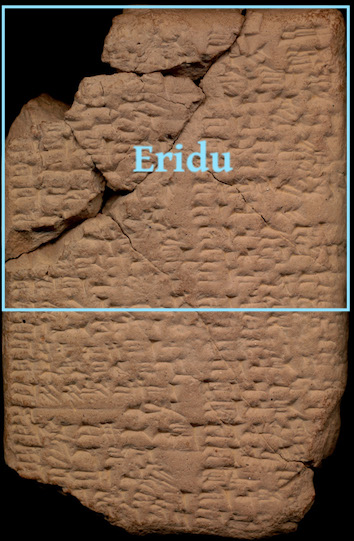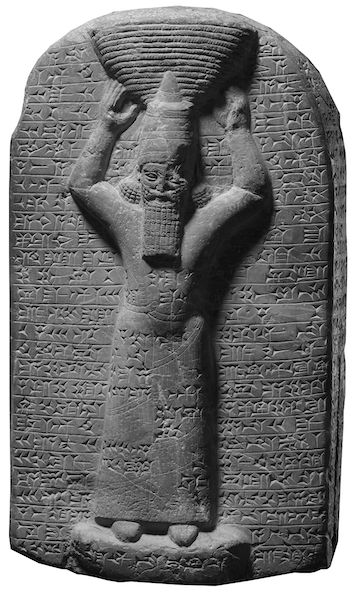Ekarzagina (temple of Ea at Babylon)

Ekarzagina was one of the thirteen religious buildings in the Eridu district of East Babylon, at least according to Tablet IV of the scholarly compendium Tintir = Babylon, where it is referred to as "Gate of the Apsû" and, thus, believed to be a cosmic quay that connected the surface of the earth — with Esagil, Babylon's principal temple, as the bond that held the universe together — to the subterranean watery abyss below it. That temple was dedicated to the god Ea, the principal divine occupant of the apsû. This important, still-to-be-discovered temple was inside the Esagil temple complex, probably close to the eastern bank of the Arahtu River, an arm of the Euphrates River that corresponds to the modern Šaṭṭ al-Ḥillah. Ekarzagina — which was surrounded by orchards, groves, and gardens — was the chief location where mīs pî ("Washing of the Mouth") and pīt pî ("Opening of the Mouth") rituals took place in order to ritually bring divine images to life; the latter ceremony took place at or near the gate called Kakiriabzu ("Gate of the Orchard of the Apsû"). Little about the history of this temple of Ea at Babylon is known.
Names and Spellings
This temple at Babylon went by the Sumerian ceremonial name Ekarzagina, which means "House, Pure Quay" or "House, Quay of Lapis Lazuli." The name is shared with Ea's sacred quay at Eridu (modern Tell Abu Shahrain), his principal cult center in Babylonia.
- Written Forms: e₂-kar-za-gin₃-na; ka-ar-za-gi-na; kar-za-gin₃-na.
In texts explaining the names of the temples in Babylon, the Sumerian name (E)karzagina is explained as Akkadian bītu kāri elli ("House of the Pure Quay") and kāru ellu ("Pure Quay"). Akkadian inscriptions of the Neo-Assyrian kings Esarhaddon (r. 680–669 BC) and Ashurbanipal (r. 668–ca. 631 BC) recording mīs pî ("Washing of the Mouth") and pīt pî ("Opening of the Mouth") rituals connected with the god Marduk's return to Babylon, refer to (E)karzigina as "a pure place" (Akkadian ašru ellu), a reference to the temple's Sumerian name.
Tintir = Babylon Tablet IV refers to Ekarzagina as the "Gate of the Apsû" (the subterranean watery domain of Ea under the earth's surface).

BM 090864, a marble stele depicting Ashurbanipal carrying a basket on his head and recording that king's restoration of Ekarzagina, the temple of the god Ea in the Esagil complex. Image adapted from the British Museum Collection website. Credit: Trustees of the British Museum.
Known Builders
- Neo-Assyrian (ca. 911–612 BC)
- Ashurbanipal (r. 668–ca. 631 BC)
Building History
Ashurbanipal, Assyria's last great king, is the only positively-known builder of Ekarzagina. Sometime between 668 BC and 652 BC, this ruler states that he had Ea's temple built anew. The Akkadian inscription commemorating this deed, unfortunately, provides no details about the project itself, including whether he both initiated and completed the project or whether he merely finished what his father Esarhaddon (r. 680–669 BC) had started while he was still alive. Given the fact that many of Esarhaddon's building projects in Babylon remained unfinished at the time of his death in late 669 BC, it is not unreasonable to assume that Ashurbanipal completed his father's work on this temple of Ea, rather than taking it upon himself to start an entirely new project in that city. Whatever the case might have been, Ashurbanipal's work on Eturkalama took place while his older brother Šamaš-šuma-ukīn (r. 667–648 BC) was king of Babylon.
The Neo-Babylonian king Nabonidus (r. 555–539 BC), Babylon's last native ruler, states in an inscription written on a basalt stele that he had a reddish gold(-plated) throne made for Ea and had it placed in that god's shrine (simakku). None of Nabonidus' presently-extant Akkadian inscriptions, however, record that that king sponsored any work on Ekarzagina's structure.
Although the temple survived into the Period Period, nothing about its post-Neo-Babylonian building history is known.
Archaeological Remains
Ekarzagina has not yet been positively identified in the archaeological record. Based on information provided in a text dating to the reign of the early first-millennium-BC king Nabû-apla-iddina, one should expect to find the temple somewhere between Esagil and the eastern bank of the Arahtu River, the branch of the Euphrates that divides Babylon in two. It should not be equated with "Cella C" of Esagil, which was partially excavated under the direction by Walter Andrae in 1900 when his workmen dug a deep 20×20-meter pit into the northern section of Esagil's main courtyard (Court of Bēl).
Further Reading
- George, A.R. 1992. Babylonian Togographical Texts (Orientalia Lovaniensia Analecta 40), Leuven, pp. 300–303.
- George, A.R. 1993. House Most High. The Temples of Ancient Mesopotamia (Mesopotamian Civilizations 5), Winona Lake, p. 108 no. 569.
- Pedersén, O. 2021. Babylon: The Great City, Münster, p. 166.
Jamie Novotny
Jamie Novotny, 'Ekarzagina (temple of Ea at Babylon)', Babylonian Temples and Monumental Architecture online (BTMAo), The BTMAo Project, a sub-project of MOCCI, [http://oracc.org/btmao/Babylon/TemplesandZiggurat/Ekarzagina/]